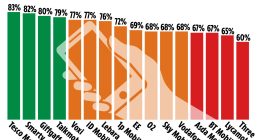
[bctt tweet=”Everything you need to know about affiliate marketing in the brave new world of 4 hour work weeks and passive incomes, one of the terms you’ll come across most often is affiliate marketing. Often, this is presented as a way to retire to the beach in Bali, where you’ll spend a few hours a day on your laptop, watching the money roll in.” username=”SDigestonline”]
While this is certainly possible, we won’t spend today talking about these sunlit uplands.
Instead, we’ll be looking at the precise steps you can take to get a successful affiliate marketing strategy up and running. But first, let’s go over a few of the basics so that everyone’s on the same page.
What is Affiliate Marketing
Essentially, affiliate marketing is when a company or brand allows third parties to advertise their products and earn a commission for each sale they make. This commission is most often a fixed percentage of the sale value.
Affiliate marketing was popularised by Amazon, but nowadays it’s well established in the mainstream of marketing techniques for companies of all sizes. Since affiliate marketing generally increases the overall number of sales, its model of revenue sharing creates a win-win scenario for both parties.
If you have a product to sell, you can offer third party marketers a cut of each sale they make to do this for you. If you don’t have a product, you can act as a sort of free agent and make money creating sales for others.
How Does Affiliate Marketing Work
There are four main actors in the affiliate marketing process. We’ve already touched on the first two. Even so, let’s look at each of them in a little bit of detail.
First up, and perhaps most importantly we have the product creator, also known as the merchant. They might be involved in other aspects of marketing themselves, or they may not. Equally, they may be an individual or a blue-chip company. The bottom line is that they’re the ones with something to sell.
Then we have the affiliate. Again, this is usually an individual but it can also be an agency. The affiliate’s role is to attract potential customers for the merchant and convince them of its value. Usually, this is through their own blog or website.
Many popular eCommerce sites are really affiliated marketers and their core, for instance, Skyscanner simply takes commissions from airlines for selling tickets on their behalf.
The third actor in affiliate marketing needs little introduction. They are the consumers. What’s worth noting however is that most companies don’t pass the costs of running an affiliate program onto their customers. Rather, it’s included in the retail price, to begin with.
Finally, we have what’s known as affiliate networks. These are intermediaries who help merchants and affiliates find each other, saving time on coming to individual revenue-sharing arrangements. These are basically databases of companies that run affiliate programs. They also handle most of the admin and payment transfers.
By far the biggest affiliate network out there is Amazon Associates, which allows you to earn a commission on any product available on Amazon.
So now that we’re all up to speed, the rest of this guide will be concerned with getting in on the affiliate marketing action.
Since you probably don’t need instructions for becoming a consumer, and you’re unlikely to set up your own affiliate network, we’ll be going step-by-step through becoming either a merchant or an affiliate.
How to Become a Merchant
Becoming a merchant is the less popular route, as it seems like a somewhat daunting task. While this is definitely a more involved process than simply becoming an affiliate, it is still doable and can be a much more reliable source of income in the longer term.
In essence, there are three main steps to becoming a merchant. You come up with an idea for a product, validate your idea by confirming if anyone will actually buy it, and finally find affiliates to market your product on your behalf.
How to come up with an idea
To many people, this seems like the hardest part, but it doesn’t have to be. This misconception comes from the idea that you have to come up with an earth-shattering new innovation that will change some industry forever.
That would be hard.
What’s easier is looking for ways to improve existing products, or coming up with ways to solve common problems which people face certain products or in certain niches. A good way to get started doing this is to read up on product reviews in your desired niche to identify a pain point.
For example, here’s a comparison article about RF baby monitors. Even in the age of smart monitors with WiFi connectivity and mobile apps, simple radio monitors still maintain a higher market share.
As you can see from the intro to this article, one of the top concerns is range. Just like with a WiFi router or a normal radio, baby monitors can suffer from range issues or dead spots, either due to flawed design or just the layout of your house.
You could alleviate this problem by selling a simple and inexpensive range extender. Equally, you could resell an existing radio range extender but repurpose it for this particular application.
The point is that finding an idea for a product is as simple as finding a common problem and offering a solution. One of the easiest ways to do this is to repurpose an existing solution for a new use or niche.
What kind of product can you create
Of course, you aren’t limited to physical products. Indeed, these are costly to design, produce and distribute, so if you want to get into affiliate marketing as a merchant, you’re more likely to go down the road of creating digital products.
You can create these for little or no financial outlay, and without much in the way of specialist skills. For instance, eBooks, podcasts and online courses require no investment other than your time and minor costs incurred in hosting or buying software.
Since these kinds of digital products are all information-based, the process of identifying a pain point is slightly different. Instead of identifying a problem, more often you simply need to find interesting topics.
This can be done using BuzzSumo to see what topics are being shared in your niche. Let’s say I want to start a digital product relating to hiking.
According to BuzzSumo, the top pieces of hiking content at the moment relate to its benefits for physical and mental health.
On the basis of this, I could start a podcast that discusses real-life success stories of people who have turned their lives around by taking up hiking. Equally, I could create a short online course to help people understand the basics of safety while hiking.
Additionally, if you do happen to have some specialist skills, then all the better. The obvious example here would be if you have some coding skills. Many SAAS and mobile app companies undertake affiliate marketing as merchants.
Regardless of the kind of digital product you create, there’s one overwhelming benefit compared to physical products. That is, once the product is created there are no manufacturing costs for new units.
That means you can afford to share larger amounts of revenue with your affiliates without eating into your margins. Because of this, you’ll often see affiliate schemes on digital products offering a 50% commission or higher.
In turn, this lets you attract better affiliates.
How to validate your idea
Now that you have your idea, the next step is to work out if anyone would actually pay for it. This is incredibly easy.
You just ask them to pay for it.
Let’s continue with the same example as before. We know that 81 people have shared the article about Scottish doctors prescribing hiking for its health benefits. We can find these people by simply searching for the URL in Twitter itself.
Then you can reply to them asking if they’d be interested in buying an online course to get started hiking. If they say yes, offer them the chance to preorder and say that if a certain number of people buy the product you’ll make it. This could be as low as 5 pre-orders to gauge interest.
Any higher a threshold wouldn’t be a reasonable expectation, as many people will be hesitant to preorder a product from a brand they don’t already have a relationship with, especially for a digital product.
How to find affiliate partners
We’ll be looking at the technical side of partnering up for affiliate marketing down below, but for now, let’s just talk about how to find the right people. The challenge here is finding people with an audience who share your interest.
We’ll continue with our hiking example. See photos here
Even a cursory Google search for ‘hiking for health’ threw up a number of blogs and communities which would make perfect affiliate partners for our course, like this hillwalking site who cross over into blogging about hiking’s mental health benefits.
Or this general fitness site who focuses on building awareness of the health benefits of different kinds of exercise.
This is ideal because it’s much easier to pitch potential partners when your interests and audiences are already aligned. Then emailing them to partner up and share revenue is a clear win-win.
This illustrates a really crucial point. The better defined your niche is, the easier it will be to convince potential partners to share revenue as part of your affiliate program.
How to become an affiliate marketer
Now let’s look at the other side of affiliate marketing – becoming an affiliate. As we’ve said already, the process of getting started here is much quicker. In fact, it’s easily achieved using a replicable marketing funnel which I’ll walk you through in detail in a few moments.
As an overview though, this is going to involve a simple process of content creation, email marketing and selling through webinars. Once this funnel is in place and working smoothly, you’ll then scale it by attracting more traffic through PPC.
But before we get to that, there’s one other big question to answer.
How much can you earn as an affiliate?
Like many things, the truthful answer is it depends. We’ve all heard about the superstar affiliates who are raking in hundreds of thousands in profits every month. Plenty of experience affiliates are also satisfied with a few hundred dollars.
Then some are making a fat zero.
Besides actually knowing what you’re doing – which you will by the end of this article, this discrepancy can be explained by which merchants you choose to partner up with, and what niche you’re working in.
The divide between physical and digital products is clear here too. For instance, the absolute best commission you’re likely to get on physical products is Amazon’s top rate of 10%. That means that, unless you’re in a high-end niche, you’ll need to make a lot of sales for any meaningful income.
Or in other words, you’ll probably give up before you make any real money.
On the other hand, SAAS companies tend to have far more lucrative affiliate schemes, typically offering between 40-60%, or around $60-200 per sale. Often, these will also offer recurring payments when you sell a subscription.
You may have noticed that pretty much every blog and youtube video on the web is trying to sell you web hosting. This isn’t a coincidence. In fact, there are two main factors leading them to do this. First, there’s pretty much infinite demand for web hosting.
That is, there’s an ever-growing number of websites. They all need hosting.
Even more importantly, the commissions offered by web hosting companies for affiliate marketing are frankly bonkers. Most will offer around $100 per sale, but in certain circumstances, you can make as much as 500% of the sale price. That’s not a typo either.
In general, well-known brands offer the best conversions. This creates a trade-off where digital products offer higher commissions, but physical products tend to convert better.
In summary, the magic formula for a high paying affiliate scheme is a higher demand for the product, low competition with other affiliates and a decent rate of commission. Now let’s talk about how to find this.
How to find affiliate marketing programs
Now that we know what we’re looking for, let’s talk about where to find it. One option you’ll sometimes see mentioned is cold emailing potential companies. However, unless you have a corner on a specific niche and a large existing audience, this is probably a waste of your time.
Additionally, many brands, especially in the SAAS sphere run in-house affiliate programs, which you can usually find a sign-up link for at the bottom of their site. This is a good option if you’re committed to the SAAS sphere, but then you have to do the legwork and actively seek out programs.
Really, this is only a good option if you’re intending to partner with a small number of very high-value merchants.
For this reason, the most common way to find affiliate marketing programs is by using affiliate networks. As we discussed earlier, these are online marketplaces where affiliates and merchants can find each other. They also handle most of the admin side of things, like payment processing.
There is any number of popular networks out there, but my favorite is MunchEye. To me, its main selling point is that it specifically advertises affiliate programs for products that are about to launch or have only launched recently.
There are two benefits to this. One is that commissions will typically be higher as the brand is seeking to get their new product of the ground with the first wave of sales. The other is that they’ll be putting more effort into their other marketing channels than usual to create buzz.
You’ll also notice the big launches column on the left-hand side. These are product launches from established brands and big players. Basically anything here is likely to return a high volume of sales, which makes MunchEye a great resource for affiliate marketing.
How to Use Content Marketing to sell products
At this point, you know where to find high-value affiliate programs, so it’s time to start selling products. Your first step is coming up with a well-defined niche, where you’re able to review products.
Don’t spread your net too wide. The more specific your niche is the better. Think about it. If you were to start a blog in 2019 to review makeup brands, you’re going to be on the back foot.
In fact, you’d be competing with about a million established voices.
Whereas if you want to stay in the cosmetics niche, you might have better success in establishing yourself in something more specific, like anti-balding shampoos. I like looking for a niche I’m already interested in.
That way, you’re already familiar with the products you’re going to be reviewing, so you have a head start in terms of creating content. Then you simply offer readers the chance to buy the products in question through your affiliate link and collect your profits.
Here’s a couple of tips for creating content.
One thing to keep in mind is that if your product reviews read like sales copy, your readers will see straight through you and go elsewhere. People want genuine reviews. While you need to balance this with your need to make sales, authenticity is king.
You also have options beyond straight reviews. Product comparison style articles are a great way to work with multiple merchants, by highlighting the benefits of a number of different brands which may not be in direct competition, either because of their specific use or price point.
However, using placing affiliate links in your content marketing is only the first step, as you’ll need massive amounts of traffic to make any serious money by doing this alone. Many affiliate marketers don’t get beyond a few hundred dollars in sales because they don’t take these next steps.
How to promote a product to your email list
Part of the problem is that most readers won’t make a purchase on their first visit to your site, so gathering emails is crucial to making a sale. At the absolute minimum, you should be doing this using an exit-intent pop-up to encourage visitors to sign up to your list before they leave.
If you’ve selected a niche which is sufficiently specific, this shouldn’t be difficult. The dominant wisdom is that in order to get a signup, you have to offer potential customers something of value in return.
But if you’ve picked your niche correctly, the fact that they’re on your site at all means that they’re interested in your topic of choice. That way, they should be more than happy to receive your weekly newsletter on a topic that already interests them.
This newsletter can be as simple as letting your audience know when your latest review is live, with a view to improving repeat traffic. This gives you another shot at making a sale through affiliate marketing.
Once again, however, if you only get as far as this point, you’re limited by your organic traffic. Any sales only make your affiliate marketing sustainable in the interim.
Once you’re up to a few hundred subscribers you can move onto the third part of the funnel.
How to promote a product on a webinar
Webinars have one massive selling point. It’s simply far more compelling to see a product in action than it is to read a review online. That’s why car dealerships offer test drives, rather than relying on magazines alone.
You can use the same principle to get your email subscribers to sign up for a free webinar. Here, you’ll demonstrate some of your favorite products in action. This can be as simple as demonstrating the features and uses of the product, as well as your personal experience with it.
Even better, webinars offer you the chance to address customers’ concerns in real-time, which blogging alone could never offer. Then you simply use some soft selling at the end of the video to point them towards your affiliate link.
You should promote each webinar for about a week in advance across all of your channels. This allows you to negotiate a discount with the merchant if you have a few hundred people have signed up.
To wrap up your webinar, emphasize that this is time-limited.
For presentation, you want to avoid is coming across like one of those 90s infomercials from the shopping channels. Instead, a simple Google Hangout in front of a plain background will suffice.
Depending on your time commitment, you may choose to pre-record an evergreen webinar. In general, though, live is always best in terms of customer engagement. This is where the bulk of your bottom of funnel sales will occur, so it’s worth the effort.
And that’s your funnel in place. Let’s look at how to scale it.
How to generate affiliate revenue through PPC
Once you’ve made a few sales through affiliate marketing, you can start to reinvest this money. The goal is to get more people into your funnel. This can be achieved through paid advertising on Google and Facebook.
There are three goals you can pursue this way. Growing your mailing list, getting sign-ups for your webinar or making more sales. You might be thinking – shouldn’t I just advertise my blog? – and the answer is no.
PPC aimed at getting people to the top of your funnel isn’t a good strategy. They’re still unlikely to make a sale after the first visit to your site. You’re better off trying to get them in further down the funnel. Then improve organic traffic through SEO.
You want to get your paid traffic to enter as far down your funnel as possible. Your best bet is actually to promote your webinar. Think about it this way. There’s a higher chance they’ll make a sale straight off the bat and you’ll already have their email.
Even if they don’t make a purchase straight away, you can send them back to the middle of the funnel. This involves sending out your automated newsletter and webinar invitations.
Then when you’ve got your funnel working just right, you can start increasing the amount you spend on PPC. This is where your affiliate marketing blows up.
How to promote a product with bots
One way to save time and make your affiliate marketing business more sustainable is to automate certain functions. One of the best ways to do this is by using chatbots on your blog.
These come into their own in a few main ways. Firstly, customers can ask questions along the lines of what is the best… You’ll be able to point them towards the relevant article on your site. You could even provide an affiliate link.
But maybe this isn’t a product area you’re already covering. These customer queries are a good indicator of a lucrative new avenue for merchants to partner up with.
Additionally, chatbots make presenting your webinars less labor-intensive. Offering responses to common customer queries frees you up to respond to more in-depth or unforeseen questions. In time, this will even let you transition away from live webinars.
Similarly, implementing a Facebook chatbot can be used to promote affiliate links. They signpost visitors towards your webinar depending on their opening query.
Getting started affiliate marketing: conclusion
That was quite a long one, so let’s briefly recap. Affiliate marketing is an excellent way to generate money, either as a side hustle or as a full-time gig. To do this you have two main options – either become a merchant or an affiliate.
Becoming a merchant involves creating a physical or digital product. You then ensure that people will actually want to buy it. Then you partner up with affiliate marketers to do the legwork of selling your product.
On the flip side, becoming an affiliate involves partnering up with merchants. You then review their products. You then send readers down a funnel of email marketing, eventually making the bulk of your sales through webinars. Once this funnel is optimized, you scale it with PPC traffic.
Then how far to take your affiliate marketing business is up to you.
Is this article helpful in providing you with the necessary information about how to make a fortune in online business? A magazine has been designed to educate you on Affiliate Marketing: Click Here To Get Your FREE Copy
Article source: Launchspace.net








